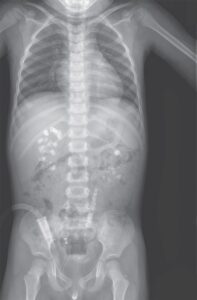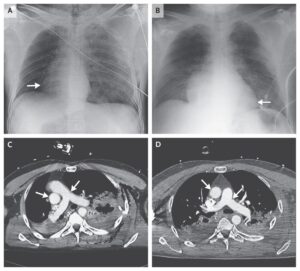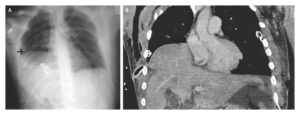This article is an answer to the case – Woman with Fever, Malaise and Peeling Rash
The patient presents with toxic epidermal necrolysis (TEN), a severe mucocutaneous disease in the same spectrum as Stevens–Johnson syndrome (SJS).
TEN has an average mortality between 25% and 35%. SJS/TEN is almost always due to drug exposures and is caused by massive keratinocyte death, which leads to separation of the skin at the dermal–epidermal junction.
Symptoms and Clinical Presentation
It presents typically with a prodrome of symptoms including fever, malaise, lymphadenopathy, pharyngitis and/or conjunctivitis, which can precede the skin findings by several days.
The cutaneous manifestations of SJS/TEN include erythema and erosions that favour the trunk and face and later may involve the extremities. The oral, ocular and genital mucosae are involved in the vast majority of cases.
During progression of the disease, the erythematous patches appear dusky and may take on a grey hue that represents epidermal necrosis.
Large areas of skin can resemble wet cigarette paper that sloughs off with minor friction or trauma (Nikolsky’s sign). Flaccid blisters demonstrate the Asboe-Hansen sign, which is the extension of the blister sideways by slight pressure of the thumb due to the lateral displacement of necrotic epidermis.
The distinction between SJS and TEN is made upon the total body surface area (BSA) involved. SJS involves <10% of BSA, SJS/TEN overlap involves 10%–30% of BSA and TEN involves >30% of BSA.
Associated Medications
Medications that are most often associated with SJS/TEN include:
- antimicrobials (aminopenicillins and trimethoprim–sulfamethoxazole),
- antiretroviral medications (particularly non-nucleoside reverse transcriptase inhibitors),
- allopurinol
- anti-epileptic drugs (carbamazepine, phenytoin, lamotrigine and barbiturates).
Treatment
Areas of detached epidermis typically heal with re-epithelialization occurring within 3 weeks without any need for skin grafting.
However, it is important to consult ophthalmology, gynecology and/or urology for the evaluation of mucosal involvement, as the manifestations on the mucosal surfaces can lead to sequelae such as symblepharon, conjunctival synechiae, entropion or blindness in the eyes and phimosis or vaginal synechiae in the genital mucosae.
Treatment of SJS/TEN includes the prompt removal of any or all potential offending drugs, admission to an intensive care unit (ICU) or burn unit with skilled nursing care, monitoring for fluid and electrolyte imbalances, maintenance of caloric intake and nutrition, and appropriate dressings to the denuded areas.
There are no specific systemic treatments for SJS/TEN that have demonstrated efficacy in clinical trials, but several treatments have been reported in small case series, which include systemic corticosteroids, intravenous immunoglobulins (IVIg), cyclosporine, cyclophosphamide, plasmapheresis and anti-tumor necrosis factor-alpha (TNF-α) agents such as etanercept and infliximab.



